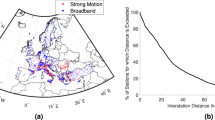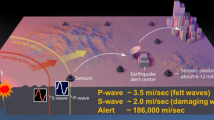Abstract
In June 2012, the Israeli government approved the offer of the creation of an earthquake early warning system (EEWS) that would provide timely alarms for schools and colleges in Israel. A network configuration was chosen, consisting of a staggered line of ∼100 stations along the main regional faults: the Dead Sea fault and the Carmel fault, and an additional ∼40 stations spread more or less evenly over the country. A hybrid approach to the EEWS alarm was suggested, where a P-wave-based system will be combined with the S-threshold method. The former utilizes first arrivals to several stations closest to the event for prompt location and determination of the earthquake’s magnitude from the first 3 s of the waveform data. The latter issues alarms, when the acceleration of the surface movement exceeds a threshold for at least two neighboring stations. The threshold will be chosen to be a peak acceleration level corresponding to a magnitude 5 earthquake at a short distance range (5–10 km). The warning times or lead times, i.e., times between the alarm signal arrival and arrival of the damaging S-waves, are considered for the P, S, and hybrid EEWS methods. For each of the approaches, the P- and the S-wave travel times and the alarm times were calculated using a standard 1D velocity model and some assumptions regarding the EEWS data latencies. Then, a definition of alarm effectiveness was introduced as a measure of the trade-off between the warning time and the shaking intensity. A number of strong earthquake scenarios, together with anticipated shaking intensities at important targets, namely cities with high populations, are considered. The scenarios demonstrated in probabilistic terms how the alarm effectiveness varies depending on the target distance from the epicenter and event magnitude.










Similar content being viewed by others
References
Allen RM (2007) The ElarmS earthquake early warning methodology and its application across California. In: Gasparini P, Manfredi G, Zschau J (eds) Earthquake early warning systems. Springer, Berlin, pp 21–44, ISBN-13 978-3-540-72240-3
Allen RM, Kanamori H (2003) The potential for earthquake early warning in southern California. Science 300:786–789
Allen RM, Gasparini P, Kamigaichi O, Böse M (2009) The status of earthquake early warning around the world: an introductory overview. Seismol Res Lett 80(5):682–693
Allen RM, Baer G, Clinton J, Hamiel Y, Hofstetter A, Pinsky V, Ziv A, Zollo A (2012) Earthquake early warning for Israel: recommended implementation strategy, GSI/26/2012 or GII 500/676/12 reports, December 2012. GSI and GII, Jerusalem
Amiran DHK, Arieh E, Turcotte T (1994) Earthquakes in Israel and adjacent areas: macroseismic observations since 100 B.C.E. Isr Explor J 44(3–4):260–305
Campbell KW, Eeri M, Bozorgnia Y (2008) NGA ground motion model for the geometric mean horizontal component of PGA, PGV, PGD and 5% damped linear elastic response spectra for periods ranging from 0.01 to 10 s. Earthq Spectra 24(1):139–171. doi:10.1193/1.2857546
Caprio M, Wiemer S, Hiemer S, Meier MA, Spada M (2013) Sybil: a system to evaluate performances of ideal earthquake early warning based on stochastic models. AGU fall meeting, December 9–13, 2013, San Francisco, USA
Espinosa-Aranda JM, Cuellar A, Rodriguez FH, Frontana B, Ibarrola G, Islas R, Garcia A (2011) The seismic alert system of Mexico (SASMEX): progress and its current applications. Soil Dynam Earthquake Eng 31:154–162
Feigin G, Shapira A (1994) A unified crustal model for calculating travel times of seismic waves across the Israel seismic network, IPRG report no. Z1/567/79(107). IPRG, Holon
Horiuchi S, Negishi H, Abe K et al (2005) An automatic processing system for broadcasting earthquake alarms. Bull Seism Soc Am 95:708–718
Horiuchi S, Horiuchi Y, Yamamoto S, Nakamura H, Wu C, Rydelek PA, Kachi M (2009) Home seismometer for earthquake early warning. Geophys Res Lett 36(5)
Hsiao NC, Wu YM, Shin TC, Zhao L, Teng TL (2009) Development of earthquake early warning system in Taiwan. Geophys Res Lett 36(5)
Ionescu C, Böse M, Wenzel F, Marmureanu A, Grigore A, Marmureanu G (2007) An early warning system for deep Vrancea (Romania) earthquakes. In: Earthquake early warning systems. Springer, Berlin, pp 343–349
Kanamori H (2005) Real-time seismology and earthquake damage mitigation. Annu Rev Earth Planet Sci 33:195–214
Klar A, Meirova T, Zaslavsky Y, Shapira A (2011) Spectral acceleration maps for use in SI 413 amendment No. 5. GII report no. 522/599/11, NBRI report no. 2012938–1 (in Hebrew). GII, Lod
Kuyuk HS, Allen RM, Brown H, Hellweg M, Henson I, Neuhauser D (2014) Designing a network-based earthquake early warning algorithm for California: ElarmS-2. Bull Seism Soc Am 104:162–173. doi:10.1785/0120130146
Mori J, Abercrombie RE (1997) Depth dependence of earthquake frequency-magnitude distribution in California: implications for rupture initiation. J Geophys Res 102(B7):15081–15090
Nakamura Y (1998) On the Urgent Earthquake Detection and Alarm System (UrEDAS), 9th world conference on earthquake engineering, vol VII, pp 673–678
Odaka Y, Ashiya K, Tsukada S, Sato S, Ohtake K, Nozaka D (2003) A new method of quickly estimating epicentral distance and magnitude from a single seismic record. Bull Seismol Soc Am 93:526–532
Olson EL, Allen RM (2005) The deterministic nature of earthquake rupture. Nature 438:212–215
Oth A, Böse M, Wenzel F, Köhler N, Erdik M (2010) Evaluation and optimization of seismic networks and algorithms for earthquake early warning—the case of Istanbul (Turkey). J Geophys Res 115:B10311
Pinsky V (2012) Assumptions and guidelines for building earthquake early warning system in Israel. GII report no. 500/682/12. Prepared for National Steering Committee for Earthquake Preparedness, Prime Minister’s Office. GII, Lod
Satriano C, Lomax A, Zollo A (2008) Real-time evolutionary earthquake location for seismic early warning. Bull Seism Soc Am 98:1482–1494
Satriano C, Elia L, Martino C, Lancieri M, Zollo A, Iannaccone G (2010) PRESTo, the earthquake early warning system for Southern Italy: concepts, capabilities and future perspectives. Soil Dyn Earthquake Eng. doi:10.1016/j.soildyn.2010.06.00
Shapira A, Hofstetter A (2002) Seismicity parameters of seismogenic zones. GII report no. 02/230/592
Shapira A, Hofstetter A (2008) Earthquake hazard assessment for building codes. USAID report. April 2000-March 2007, grant no. PCE-G-00-99-00038. USAID, Washington, DC
Stankiewicz J, Bindi D, Oth A, Parolai S (2013) Designing efficient earthquake early warning systems: case study of Almaty, Kazakhstan. J Seismol 17(1125–1137):2013. doi:10.1007/s10950-013-9381-4
Wald DJ, Quitoriano V, Heaton TH, Kanamori H (1999) Relationship between peak ground acceleration, peak ground velocity, and modified Mercalli intensity in California. Earthq Spectra 15(3):557–564
Wu YM, Kanamori H (2005a) Experiment on an onsite early warning method for the Taiwan early warning system. Bull Seism Soc Am 95:347–353
Wu YM, Kanamori H (2005b) Rapid assessment of damaging potential of earthquakes in Taiwan from the beginning of P waves. Bull Seism Soc Am 95:1181–1185
Wu YM, Yen HY, Zhao L, Huang BS, Liang WT (2006) Magnitude determination using initial P waves: a single-station approach. Geoph Res Lett 33:L05306
Zaslavsky Y, Shapira A, Gorstein M, Kolmanovich M, Giller V, Perelman N, Livshits I, Giller D, Dan I (2005) Site response from ambient vibrations in the towns Lod and Ramle (Israel) and earthquake hazard assessment. Bull Earthquake Eng 3(3):355–381
Zaslavsky Y, Shapira A, Ataev G, Gorstein M, Aksinenko T, Kolmanovich M, Perelman N, Hofstetter R (2009) Using ambient noise measurements in the process of assessing earthquake hazard in urban areas: examples from Israel. In: Miura T, Ikeda Y (eds) Earthquake engineering: new research. Nova, Commack, pp 156–219
Zohar M, Marko S (2012) Re-estimating the epicenter of the 1927 Jericho earthquake using spatial distribution of intensity data. J Appl Geoph 82(2012):19–29
Zollo A, Lancieri M, Nielsen S (2006) Earthquake magnitude estimation from peak amplitudes of very early seismic signals on strong motion records. Geophys Res Lett 33(23):L23312
Zollo A, Amoroso O, Lancieri M, Wu YM, Kanamori H (2010) A threshold-based earthquake early warning using dense accelerometer networks. Geophys J Int 183:963–974
Acknowledgments
I am grateful to Dr. Avi Shapira for initiating and guiding my study of the EEWS in Israel. The author expresses gratitude to the staff of the international committee, which elaborated the recommendations for building the EEWS in Israel (Allen et al. 2012), the resulting document forming the basis of this article. The work benefitted a lot from remarks and corrections of Dr. Kevin Fleming from the Centre for Early Warning, GFZ Potsdam, who was the first reviewer. Thanks also to the second anonymous reviewer, whose comments helped to improve the scientific contents of the paper.
Author information
Authors and Affiliations
Corresponding author
Rights and permissions
About this article
Cite this article
Pinsky, V. Modeling warning times for the Israel’s earthquake early warning system. J Seismol 19, 121–139 (2015). https://doi.org/10.1007/s10950-014-9454-z
Received:
Accepted:
Published:
Issue Date:
DOI: https://doi.org/10.1007/s10950-014-9454-z




